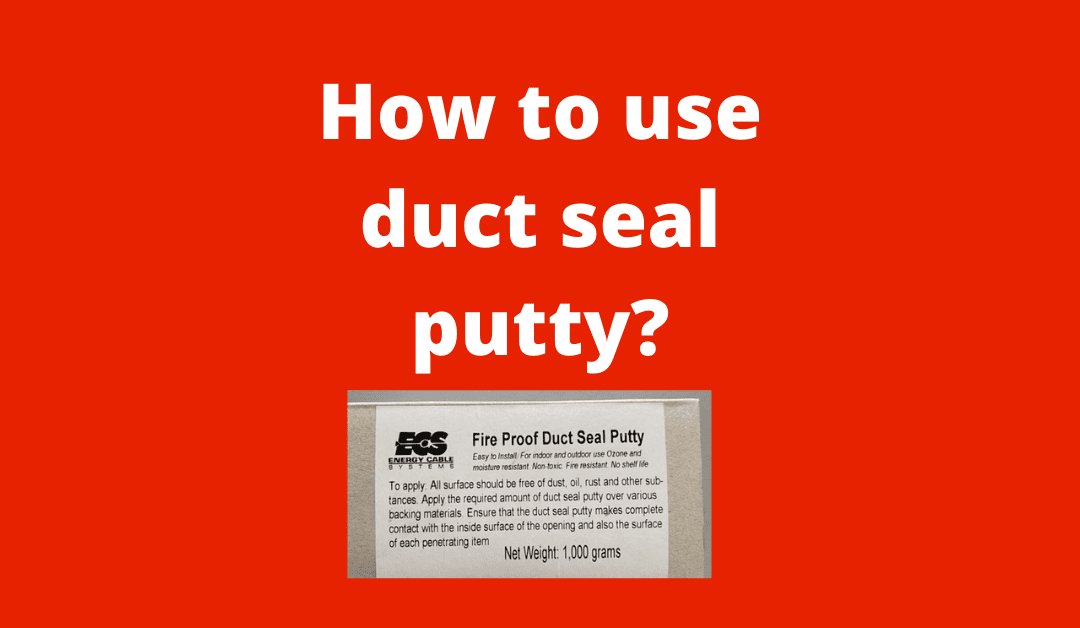Are there any leaks in your HVAC? If you have noticed any holes in your HVAC ductwork, you probably need some air duct seal. Those small holes can become big problems over time and cause significant energy loss.
You can clean your air duct system with Proair duct cleaning equipment. Fortunately, duct seal putty is a cheap and easy solution. These sealants effectively close all visible holes and crack compactly with a nutty, greasy paste. This article will answer all your questions and more!
What is Duct Seal Putty?
Duct seal putty is a non-hardening, non-toxic, pliable air duct sealing compound designed to seal ductwork without a compressor or refrigerant. It seals leaks in rectangular and round ducts. The product has been tested and approved by an independent testing laboratory for use in air conditioning and air handling systems.
Once this putty gets applied, it stays flexible for the system’s life. There is no need to remove the product when replacing equipment or making repairs. Duct Seal Putty will not damage or corrode metal or plastic when properly implied.
Is duct seal the same as plumbers putty?
Duct seal putty is a compound used to seal ductwork and other HVAC components. It is similar to a plumber’s putty but is made with materials that can withstand higher temperatures.
Plumber’s putty is a soft, easy to mold substance used when installing sinks and faucets. It forms a watertight seal around the sink’s base, where it meets the countertop. Duct seal putty has similar properties, but as its name suggests, it is formulated for use with ducts and other types of heating and cooling components.
The main differences between duct seal putty and plumber’s putty are the ingredients used to make them and their melting points. Also, Duct seal putty never dries out.
Benefits of Air Duct Seal Putty:
The benefits of air duct seal putty are as follows:
- Cost-effective repair for small leaks and cracks
Sealing the ductwork is critical for proper construction and maintenance. Air duct seal putty is ideal for these situations, as it is typically less expensive than tapes and other types of sealants but equally effective at creating a reliable seal.
- No Mess
The greatest benefit of air duct seal putty is that you don’t have to think about a mess to clean up afterward. Unlike other products on the market, this sealant doesn’t dry hard or leave residue behind on your hands. It’s so easy to utilize that anyone can handle it without questions or concerns about what it will do to their home or HVAC system.
- Fixing small holes in existing ducts
In older homes especially, ducts may develop pinholes. These leaks can get fixed using an air duct seal putty, which will form a permanent bond with the metal surface.
- Flexible bonding material
Some types of industrial tapes and adhesive products do not adhere well to flexible materials like rubber or plastic. This can make their gas hoses impossible without significant preparation to the surface. Air duct seal putty can get used to repair these items because it will remain flexible when cured.
- Non-toxic and safe for use in tight spaces
The vast majority of air duct seal putties are non-toxic, making them safe for use in areas where ventilation is poor or there is limited access to safety equipment.
Can I seal my own ductwork?
The air Duct Seal Putty is a self-adhesive material that bonds around the seams in your ductwork. The putty sticks to itself and will not pull away or come off. The putty is a permanent solution for sealing ductwork, so you won’t have to worry about leaks again.
The duct seal putty is easy to use and can get easily removed if needed. You can seal your own duct system without any special tools or skills. It gets recommended that you wear disposable gloves while using the putty.
How to use duct seal putty?
Duct seal putty is a handy solution for sealing duct connections. It is easy to use and can get applied to many types of surfaces. To use air duct seal putty, follow these steps:
Determine the location of the air duct leaks. You can do this by turning on the heating or cooling system and feeling for cool or warm air coming from areas where it shouldn’t be. You may also hear a hissing sound near the leak.
Review your options for sealing ducts. Based on your specific situation, you can use air duct seal putty to fix small holes and cracks in metal ductwork or a mastic sealant to repair larger holes in metal or flexible ducts.
Clean the area around the leak with a damp cloth. Remove any dust and debris that may interfere with the sealant application process. Allow the ductwork area to dry completely before moving on to Step 4.
Apply a thin layer of air duct seal putty around the hole or crack, covering it completely. Allow it to dry for about 25-30 minutes before turning on your heating or cooling system again.
Does duct seal putty get hard?
Once the putty is spread out and the ducts are sealed, the putty can be left in place. It will not harden or dry out but will remain pliable and flexible for years. When you need to change the ducts, you can slice through the putty with a knife or cut it away with your fingers.
Air duct seal putty is made from organic ingredients such as corn oil and clay. It has no harmful chemicals or toxins harmful to the environment, so it’s safe for use around humans and animals. It’s also simple to clean up if you don’t use all of it right away, which you can’t say about other adhesives.
